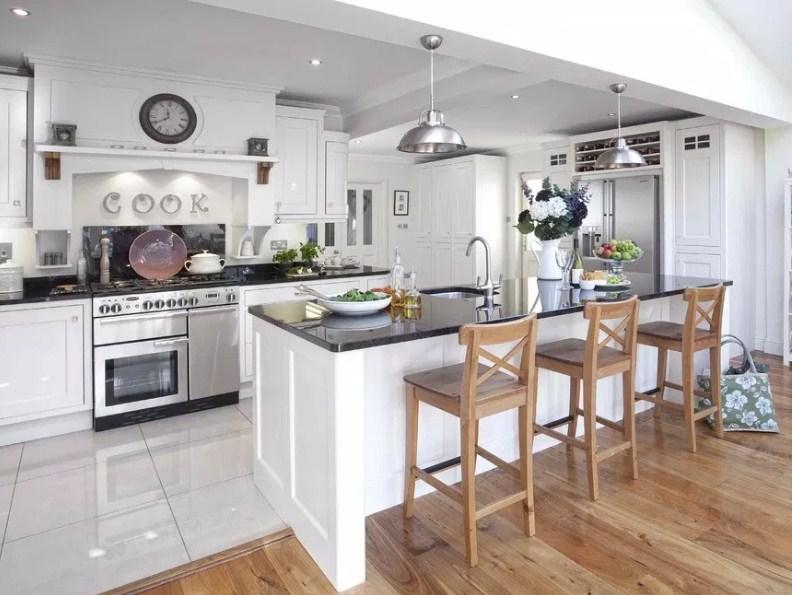When it comes to creating a seamless flow in your home, transitioning from one type of flooring to another can be a challenging task. One common area where this is often necessary is the kitchen, where tile flooring meets wood flooring. The transition between these two different materials needs to be both functional and aesthetically pleasing. In this article, we will explore the 10 best kitchen tile to wood transition ideas to help you achieve a harmonious look in your home.

1. T-Molding
T-molding is a popular choice for kitchen tile to wood transitions because of its simplicity and effectiveness. This type of molding is shaped like a "T" and fits snugly between the two different types of flooring. The top of the "T" covers the gap, while the stem fits into the space between the floors, providing a smooth transition. T-molding comes in various materials, including wood, metal, and plastic, allowing you to match it with your existing décor.
Pros:
- Easy to install
- Affordable
- Available in various materials and colors
Cons:
- May not be suitable for uneven floor heights
2. Threshold or Reducer Strips
Threshold or reducer strips are another excellent option for kitchen tile to wood transitions, especially when there is a slight difference in height between the two floors. These strips come in a range of materials, including wood, metal, and vinyl, and are designed to bridge the height gap smoothly. They provide a gentle slope from one flooring type to another, ensuring a trip-free transition.
Pros:
- Ideal for height differences
- Available in multiple materials
- Durable
Cons:
- Can be more noticeable than other transition options
3. Flush Transitions
A flush transition is one of the most seamless ways to connect kitchen tile to wood flooring. This method involves installing both floors at the same height, creating a smooth, level transition. This can be achieved by adjusting the subfloor height or using underlayment to ensure both surfaces are even. The result is a clean, modern look that is barely noticeable.
Pros:
- Seamless appearance
- Modern and sleek
Cons:
- Requires precise installation
- May need professional assistance
4. Border Tiles
Using border tiles is an innovative and decorative way to transition from kitchen tile to wood flooring. This method involves installing a row of decorative tiles where the two flooring types meet. These border tiles can be a contrasting color or pattern, creating a visual break that adds interest to the space. This approach works particularly well in open-plan kitchens.
Pros:
- Adds a decorative element
- Creates a defined boundary
Cons:
- Requires careful planning
- Can be more expensive
5. Metal Transition Strips
Metal transition strips offer a sleek and modern solution for kitchen tile to wood transitions. These strips are typically made of aluminum or stainless steel and provide a durable and stylish way to connect different flooring materials. They are particularly useful in contemporary or industrial-style kitchens.
Pros:
- Modern and stylish
- Durable
- Easy to clean
Cons:
- Can be cold and stark
6. Wood or Tile Inlays
Wood or tile inlays are a sophisticated way to create a custom transition between kitchen tile and wood flooring. This method involves installing a strip of wood or tile between the two flooring types, often in a contrasting color or pattern. This can create a unique and personalized look that enhances the overall design of your kitchen.
Pros:
- Customizable
- Adds a unique design element
Cons:
- Requires skilled installation
- Can be costly
7. Vinyl Transition Strips
Vinyl transition strips are a versatile and cost-effective option for kitchen tile to wood transitions. These strips are available in a wide range of colors and patterns, making it easy to find one that matches your flooring. Vinyl strips are also flexible, making them ideal for areas where the floors are not perfectly level.
Pros:
- Affordable
- Available in many colors and patterns
- Flexible
Cons:
- May not be as durable as other materials
8. Carpet Trim
Carpet trim, also known as transition carpet strips, can be used as a creative way to transition between kitchen tile and wood flooring. This involves placing a strip of carpet or carpet-like material between the two floors. This approach is particularly useful in homes where there is a desire to add warmth and texture to the transition area.
Pros:
- Adds warmth and texture
- Soft underfoot
Cons:
- Can be more difficult to clean
- May not be suitable for high-traffic areas
9. Stone Transition Pieces
Using stone transition pieces is a luxurious way to bridge the gap between kitchen tile and wood flooring. These pieces can be custom-cut to fit the transition area perfectly and can add a touch of elegance to your kitchen. Stone transition pieces work particularly well in kitchens with natural stone countertops or backsplashes.
Pros:
- Luxurious and elegant
- Durable
Cons:
- Expensive
- Requires professional installation
10. Floating Floor Transition
A floating floor transition is an innovative approach that involves using a floating floor system, where the flooring material is not glued or nailed down but instead "floats" over the subfloor. This method can be particularly useful in areas where the subfloor may shift or expand, providing a flexible and stable transition between kitchen tile and wood flooring.
Pros:
- Flexible and stable
- Easy to install
Cons:
- Can be less durable over time
- May require special underlayment
Conclusion
Choosing the right kitchen tile to wood transition is crucial for creating a cohesive and aesthetically pleasing look in your home. Whether you opt for a simple T-molding, a decorative border tile, or a luxurious stone transition piece, the key is to select a method that complements your overall design and meets your functional needs. By considering the pros and cons of each option, you can find the perfect solution to achieve a seamless and beautiful transition between your kitchen tile and wood flooring.















